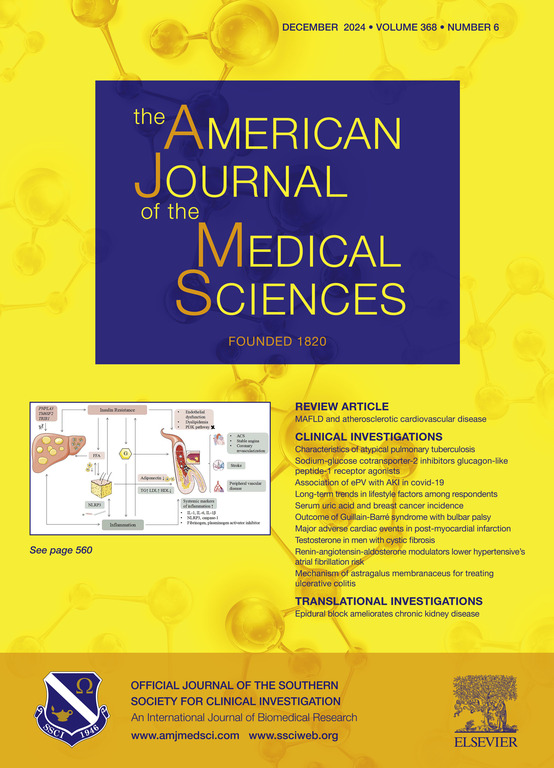代谢功能障碍相关性脂肪肝初级保健患者的消化道专科转诊模式。
IF 2.3
4区 医学
Q2 MEDICINE, GENERAL & INTERNAL
引用次数: 0
摘要
背景:随着代谢功能障碍相关性脂肪性肝病(MASLD)的治疗扩展到基层医疗机构,人们对受影响患者的专科转诊模式知之甚少。我们确定了接受消化内科(GI)会诊的 MASLD 初级医疗患者的比例,并比较了转诊和未转诊患者的晚期纤维化风险:这项对初级保健诊所电子健康记录数据的回顾性研究纳入了MASLD患者,这些患者没有其他慢性肝病诊断,也没有肝硬化病史。研究结果显示,MASLD 患者在确诊后的任何时间都会被转诊至消化内科进行评估和管理(E/M)。计算纤维化-4指数(FIB-4)评分,按晚期纤维化风险进行分类,并根据是否接受消化科E/M转诊进行比较。建立了逻辑回归模型,以确定 FIB-4 风险与接受消化道转诊的关系:该队列包括 652 名患者,其中 12% 的患者 FIB-4 评分(≥ 2.67)为晚期纤维化高风险。总体而言,31%的队列患者接受了消化道转诊治疗。接受消化道 E/M 转诊的高风险 FIB-4 评分患者的比例没有差异(12% 对 12%,P=0.952)。在调整后的逻辑回归模型中,高风险 FIB-4 评分(OR 1.01; 95% CI 0.59 - 1.71)与接受转诊无关:结论:在这项初级保健MASLD队列研究中,只有30%的患者在研究期间接受了消化道E/M转诊,接受转诊的患者在FIB-4晚期纤维化风险方面没有差异。本文章由计算机程序翻译,如有差异,请以英文原文为准。
Patterns of gastroenterology specialty referral for primary care patients with metabolic dysfunction-associated steatotic liver disease
Background
As metabolic dysfunction-associated steatotic liver disease (MASLD) management extends into primary care, little is known about patterns of specialty referral for affected patients. We determined the proportion of primary care patients with MASLD that received a gastroenterology (GI) consultation and compared advanced fibrosis risk between patients with and without a referral.
Methods
This retrospective study of electronic health record data from a primary care clinic included patients with MASLD, no competing chronic liver disease diagnoses, and no history of cirrhosis. Referral to GI for evaluation and management (E/M) any time after MASLD ascertainment was the outcome. Fibrosis-4 Index (FIB-4) scores were calculated, categorized by advanced fibrosis risk, and compared by receipt of a GI E/M referral. Logistic regression models were developed to determine the association of FIB-4 risk with receipt of a GI referral.
Results
The cohort included 652 patients of which 12% had FIB-4 scores (≥2.67) at high-risk for advanced fibrosis. Overall, 31% of cohort patients received a GI referral for E/M. There was no difference in the proportion of patients with high (12% vs. 12%, p=0.952) risk FIB-4 scores by receipt of a GI E/M referral. In adjusted logistic regression models, high-risk FIB-4 scores (OR 1.01; 95% CI 0.59 - 1.71) were not associated with receipt of a referral.
Conclusions
Only 30% of patients in this primary care MASLD cohort received a GI E/M referral during the study period, and those patients with a referral did not differ by FIB-4 advanced fibrosis risk.
求助全文
通过发布文献求助,成功后即可免费获取论文全文。
去求助
来源期刊
CiteScore
4.40
自引率
0.00%
发文量
303
审稿时长
1.5 months
期刊介绍:
The American Journal of The Medical Sciences (AJMS), founded in 1820, is the 2nd oldest medical journal in the United States. The AJMS is the official journal of the Southern Society for Clinical Investigation (SSCI). The SSCI is dedicated to the advancement of medical research and the exchange of knowledge, information and ideas. Its members are committed to mentoring future generations of medical investigators and promoting careers in academic medicine. The AJMS publishes, on a monthly basis, peer-reviewed articles in the field of internal medicine and its subspecialties, which include:
Original clinical and basic science investigations
Review articles
Online Images in the Medical Sciences
Special Features Include:
Patient-Centered Focused Reviews
History of Medicine
The Science of Medical Education.

 求助内容:
求助内容: 应助结果提醒方式:
应助结果提醒方式:


